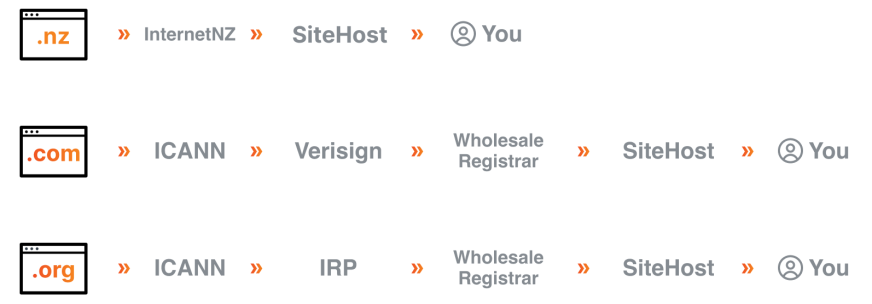Note for readers: This article was first published in October 2020. For a more recent look at ICANN and domain pricing, see Our new ICANN accreditation will shorten the domain supply chain (June 2022).
Recently, a customer contacted us to ask why there’s a price difference between .com, .net and .org domains. So we did some research and it turns out the story is quite interesting - there is a lot happening in the international domain space and price changes are likely on the way. But the story starts with ICANN so let’s dig into who they are and what they do.
Internet Corporation for Assigned Names and Numbers (ICANN) is the non-profit regulatory body that governs many of the web’s key systems, including IP space and Domain Name Systems (DNS). They run traditional domain names such as .com and .net along with newer names like .pizza and .ninja while outsourcing the day-to-day operations to for-profit third parties. These third parties then allow registrars (that’s companies like us) to sell domains to you. Think of it like this:
In the last few years, ICANN has been experiencing a bit of a backlash from the wider community because while one of their key mandates is to focus on public benefits, many of their decisions seem to be coming at a cost to customers while heavily benefitting private businesses.
For example, in 2002, the Manager of Public Participation role was created in response to concerns that ICANN had too much power. It took two years for this role to be filled and chewed through three people before being quietly removed six years later. More recently, a public proposal by ICANN to remove long standing price caps on some domain names received 98% opposition to the change. ICANN was unfazed by the comments and went ahead.
As more of these new lease agreements for domain names kick in with price cap removals, the floodgates have been opened for businesses to start increasing prices with minimal annual limits or justifications required. The first example of this was .org where the price started rising rapidly after years of being stable. For their part, ICANN justifies removing these limits for three key reasons:
To standardise their contracts for easy management. New domains had no historic pricing or contracts so the lease agreements were simpler and more flexible. ICANN’s attempt to standardise all contracts means people like you and me have to pay more. It also seems misguided that traditional domains should be treated the same as the newer, niche domain names.
To manage domain prices through market competition. It may sound nice in theory, but competition will only restrain prices if registrants can easily switch from one domain name to another (such as switching from sitehost.nz to sitehost.mobi). But domain changes are often avoided at all costs since they can be risky and impractical even just from a branding and marketing perspective.
To enhance their services like DNS. ICANN claims that the money collected will fund additional initiatives to enhance DNS security, stability and resilience, which sounds reasonable, but there are no specifics yet as to how the money is being used or why it is needed.
It’s fair to say that ICANN and the companies leasing from them such as Verisign stand to make a lot of money from the removal of price caps. According to analysts, Verisign who lease the .com namespace paid $20 million USD to ICANN for their new contract and are now predicted to make an additional $800 million in revenue as a result of price hikes beginning in 2021. These changes are also part of a larger move to revoke the Obama-era price controls, in-line with the policies of the Trump administration.
More price rises are likely on the way
It’s not over yet. ICANN’s .com contract with Verisign is up for renewal again in 2024 and analysts have predicted further price increases by the end of 2026. The .com extension covers 51.6% of all registered domain names and since it is commonly registered by commercial organisations, we can assume that most of them will have no choice but to accept the increases. With the upcoming contract renewal of the .net extension in 2023, Verisign has the ability to raise the prices of two domain extensions which represent 55% of the world’s domains.
So what can you do?
We know it’s still early and future agreements may or may not result in price hikes, but it could be a good idea to renew your domains for the longest duration that is right for you. If you’re bold enough, you could even consider moving to a more price stable domain but that comes with plenty of challenges. Ultimately, all you can do is plan ahead and make a decision when the time comes.
That’s probably not what you wanted to hear – but no matter what happens we’ll still have your back. Our domain pricing will remain competitive and we’ll continue providing the high quality support you’re accustomed to. As always, if you have any questions you know where to find us and thank you for reading.


